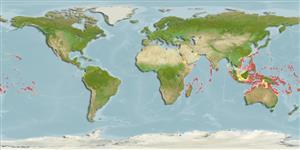Classification / Names
Common names from other countries
Main reference
Size / Weight / Age
Max length : 8.0 cm TL male/unsexed; (Ref. 9710)
Environment
Marine; reef-associated; depth range 1 - 36 m (Ref. 89972)
Climate / Range
Tropical, preferred ?; 30°N - 25°S
Distribution
Indo-Pacific: Red Sea to the Marquesan and Pitcairn islands, north to Ryukyu Islands, south to the southern Great Barrier Reef and New Caledonia.
Countries | FAO areas | Ecosystems | Occurrences | Introductions
Short description
Dorsal
spines
(total): 9;
Dorsal
soft rays
(total): 10-11;
Anal
spines: 3;
Anal
soft rays: 8;
Vertebrae: 23. Fresh specimens grayish brown to reddish brown, sometimes with dark narrow edges on scales on mid side of body. Light yellow bar on head behind and adjacent to eye; another on caudal peduncle; iris red and yellow. Juveniles (up to about 3.8 cm SL) have 2 broad pale bars on body. Spinous portions of dorsal and anal fins deeply incised. One predorsal bone.
IUCN Red List Status (Ref. 115185)
Threat to humans
Harmless
Human uses
Fisheries: of no interest; aquarium: commercial
More information
ReferencesAquacultureAquaculture profileStrainsGeneticsAllele frequenciesHeritabilityDiseasesProcessingMass conversion
Tools
Special reports
Download XML
Internet sources
Estimates of some properties based on models
Phylogenetic diversity index
PD50 = 0.6250 many relatives (e.g. carps) 0.5 - 2.0 few relatives (e.g. lungfishes)
Trophic Level
3.5 ±0.37 se; Based on food items.
Resilience
High, minimum population doubling time less than 15 months (Preliminary K or Fecundity.)
Vulnerability
Low vulnerability (14 of 100)
Price category
